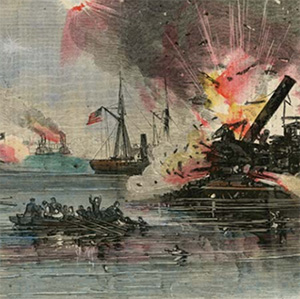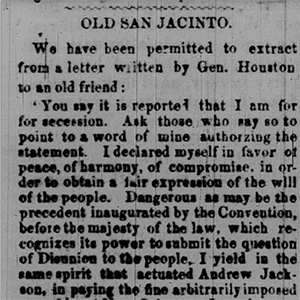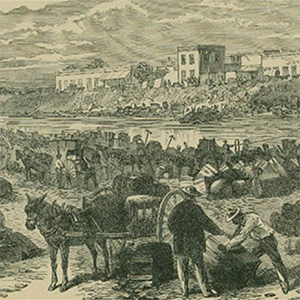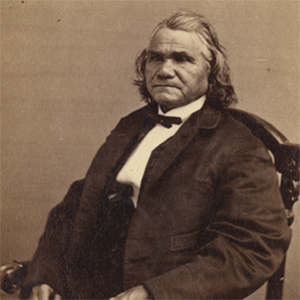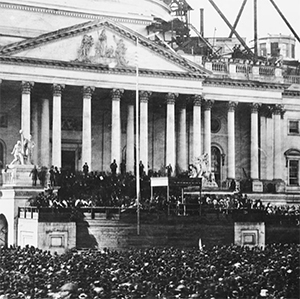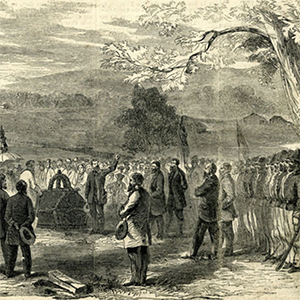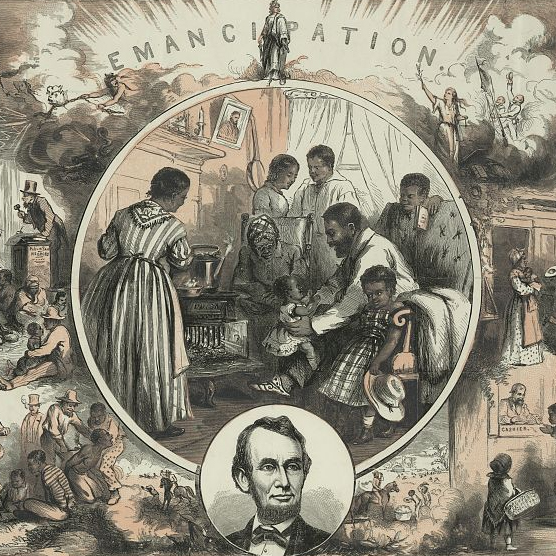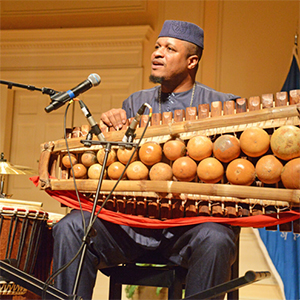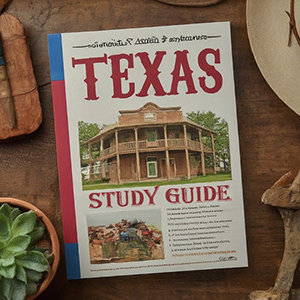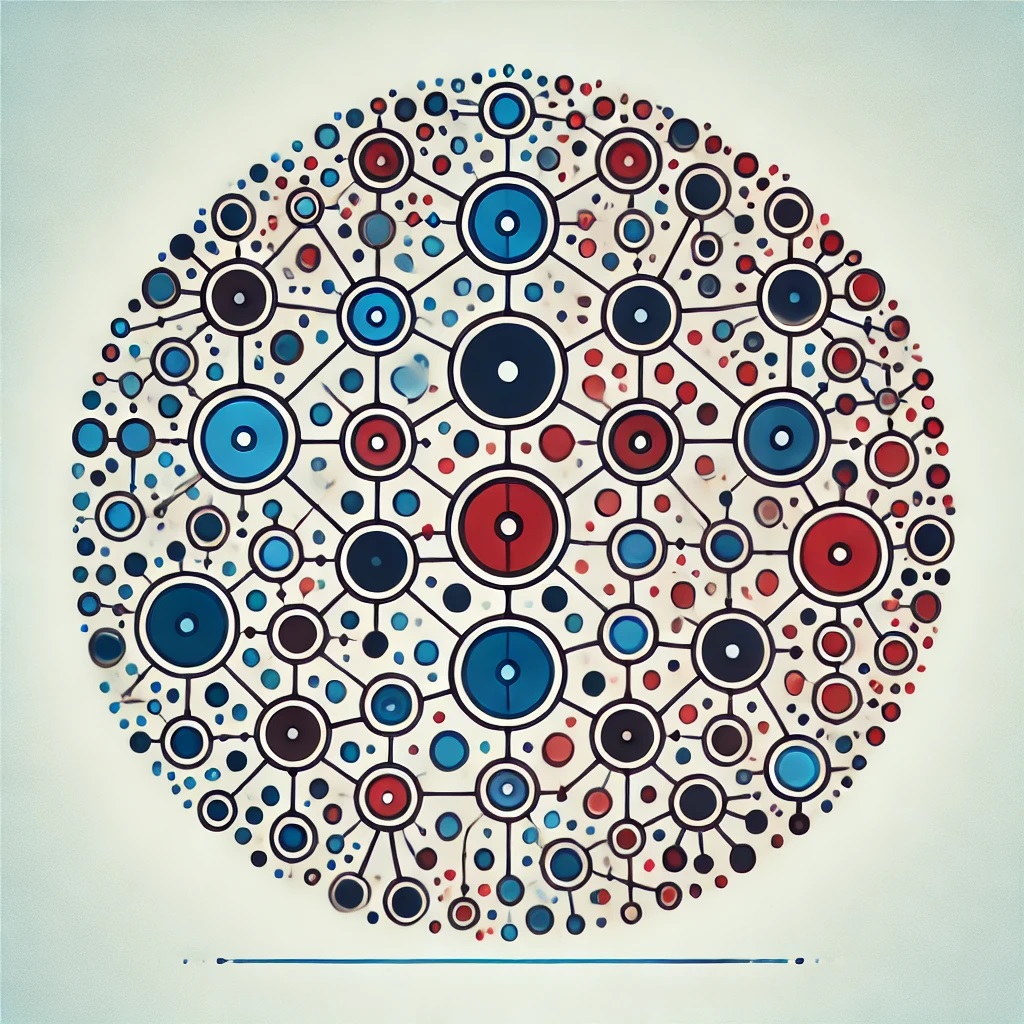In this one day lesson, students will identify and explain the key events, major themes, and defining characteristics of the Civil War era of Texas history.
THIS UNIT
Browse unit contents using the tabs to the right or the filters below.
Share
Tell other teachers, parents, and students about us.
Follow
Pacing
To meet the TEKS requirements while minimizing the amount of time spent in the unit, educators can focus solely on the following lessons (Approximately 6 - 8 class periods)
- The Big Picture (1 class period)
- Vocabulary (2 class periods)
- What’s the Story? (1-2 class periods)
- Causes of the War Guided Notes (1 class period)
- Texas and the Civil War Stations (1–2 class periods)
Contents
Era Overview
When the Civil War broke out in 1861, tens of thousands of Anglo-Texans enlisted in the new Confederate armies. A small number of Texans – most notably those who served in Hood’s Brigade – fought in battles on the eastern front, in places like Virginia and Pennsylvania. But the vast majority of Texas soldiers served on the western front, with Confederate armies along the Mississippi River. Other Texans served the state’s home guard along the edges of Anglo-Texan settlements and Indian nations. Some Texans, however, particularly within German communities, resisted the Confederacy.
Texas itself was not the scene of major battles, which allowed the state to support the Confederate war effort in three key areas. First, Texas supplied food and clothing to Confederate armies, since Texas farms had not been devastated by battles or invading Union troops. Second, Texas used its border with Mexico to break through the Union blockade that the U.S. used to prevent the Confederacy from shipping its cotton abroad. Third, Texas became a place of refuge for Confederates seeking to hide from U.S. armies. This became particularly important to Confederate slaveholders who hoped to prevent their enslaved people from running to freedom behind Union lines. As a result, Confederates brought an estimated 50,000 enslaved people to Texas during the war, swelling the enslaved population of the state to 230,000 by 1865.
When the Confederacy lost the war in 1865, legalized slavery came to an end in Texas. On June 19, 1865 – celebrated today as “Juneteenth,” a national holiday – the U.S. Army arrived in Galveston, Texas, and announced the end of slavery in Texas. Juneteenth marked a massive shift within the state, freed nearly a quarter of a million people, and began a process of remaking the state’s economic, political and social structures.
Unit Level Downloads (English)
-
Downloadable/Editable versions of the English language unit plan. Provides an Era Overview and pacing, and outlines each lesson’s estimated completion time, essential questions, a description of each lesson, and student learning experiences and activities.
Other Units
Lessons
Most lessons contain downloadable and printable documents, activities, and other resources to aid in classroom instruction. Lesson materials are available in multiple formats and typically contain variations based on learning needs.
The Big Picture
How Do We Know What We Know?
In this one day, primary-source based lesson, students will use a set of primary source materials to examine significant events, topics, and points of view related to Texas history during the Civil War era.
Vocabulary
In this two-day lesson, students will be able to identify, define and give an example of each vocabulary term within the context of the era of early Texas statehood.
What's the Story?
In this two-day lesson, students will examine six readings presenting significant events that took place during the Civil War and identify their significance to Texas history.
Who's Who of the Civil War
In this one or multi-day optional extension lesson, students will read passages about key people of the Civil War to identify and summarize each person’s significance to the era. This lesson includes multiple ways to interact with the materials including biographical fact sheets, a dinner party activity, “I have / Who has” and student worksheets.
Special Note: There are no required people in the TEKS specific to Texas in the Civil War. This lesson can be omitted in total or in part without missing state requirements.
Causes of the Civil War
In this one day guided notes lesson, students examine seven key events that led to the outbreak of the Civil War and determine the role that slavery and sectionalism played in each event.
Texas and the Civil War
In this one- to two-day lesson students will examine various aspects of Texas role in the Confederacy during the Civil War including the significant battles that took place in Texas, the Texas economy, Prisoner-of-War camps, Texas Unionists, Texan soldiers in the war, and Southern refugees to Texas.
To complete the lesson in one class period and only focus on material in the TEKS, limit the lesson to Station 1: Civil War Battles in Texas.
Emancipation Proclamation Extension
In this one day, optional extension lesson, students will analyze excerpts of the Emancipation Proclamation to identify its purpose, limitations, and significance.
Secession Extension
In this optional one-day extension lesson, students will analyze a primary source text explaining the primary reasons why the people of Texas voted in favor of secession from the Union.
Texas Today
In this one-day lesson, students examine the history and significance of Juneteenth, celebrating the day that news of emancipation arrived in Texas.
Looking Ahead
In this one day lesson, students will analyze Abraham Lincoln’s Second Inaugural Address to make observations and inferences about Lincoln’s goals for the country as the Civil War came to a close.
Study Guide and Flashcards
In this one day review lesson, students will review key terms, concepts, people, and events of the Civil War in preparation for a unit test.
Review Mind Map
In this one-day review lesson, students will create a visual representation of terms and concepts from the unit in a mind map. Students will be able to identify how information from the unit is connected by making connections between terms on a mind map.
Review Bingo Game
In this optional, one-day review lesson, students will review key terms, ideas, people, places, events, and major themes of the Civil War by playing Bingo using terms from the unit and clues about each term.
Maps
We've assembled the following list of maps that are applicable to the Civil War Unit.
[Civil] War maps and diagrams
"Map shows forts, towns, railroads, and rivers in the vicinity of Annapolis, Key West, the Mississippi River, Chesapeake Bay and vicinity, Charleston, New Orleans, Savannah, Mobile Bay, the United States, Cairo, Pensacola Bay, Galveston Bay, Norfolk, Hampton Roads, Washington, D.C., and Harpers Ferry."
Map showing the comparative area of the Northern and Southern states east of the Rocky Mountains, 1861
"Map shows states, territories, major cities, and regional boundaries in the eastern half of the mid-nineteenth century United States."
H.H. Lloyd & Co's. campaign military charts showing the principal strategic places of interest
"Map shows major cities, military outposts, boundary lines for Old California, New Mexico, Texas, and Mexico. Includes dates in notes on boundary lines."
Map showing the distribution of slaves in the Southern States
"Map shows distribution of enslaved peoples, state and territorial boundaries, and major cities; agricultural products for the southern states on inset. Includes table of statistics and key to map."
Military map of the United States & Territories : showing the location of the military posts, arsenals, navy yards, & ports of entry
"Map shows the location of military posts, arsenals, naval yards, and ports. Insets: "Key West," "Pensacola" and "Perdido" bays. Includes supplement showing locations of military operations."
Colton's United States : showing the military stations, forts & c.
"Map shows mid-nineteenth century United States geography, states, cities, and military installations. Relief shown by hachures."
Lloyd's Military Maps, Showing the Principal Places of Interest, compiled from official data by Egbert L. Viele and Charles Haskins, Military and Civil Engineers. Published under the auspices of the American Geographical and Statistical Society
"Lloyd's Military Maps, Showing the Principal Places of Interest, compiled from official data by Egbert L. Viele and Charles Haskins, Military and Civil Engineers."
Map of the United States, showing the territory in possession of the Federal Union, January 1864
"Map shows mid-nineteenth century United States geography, states, cities, and military installations. Relief shown by hachures."
How the war commenced and how near it is ended
"Map shows, by color, the territories "claimed by the confederates in 1861," "in the military possession of the Confederates in 1861," "reclaimed from rebellion by the Federal Union," and 'remaining in possession of the Rebels January, 1864.'"
Videos
We provide videos for both continuing education and classroom use. Please see each video's descriptive page for related resources and details about accessibility and viewing options.
Preview of the Civil War
A short introductory video to the Civil War Unit. Includes worksheets and/or other attachments.
Secession
The secession of Texas from the United States, covering: John Brown’s Raid, The Election of 1860, Texas and Secession.
Civil War
The U.S. Civil War, covering: War Breaks Out, Texans in the Confederate Armies Life on the Homefront, End of War, End of Slavery.
More Resources
The following list of resources provide additional information to help you dive deeper into the context of the unit. Books are linked to OCLC WorldCat, allowing you find a copy in your nearest local library or to make a request for it using interlibrary loan.
General
website Results for The Civil War in The Portal to Texas History

